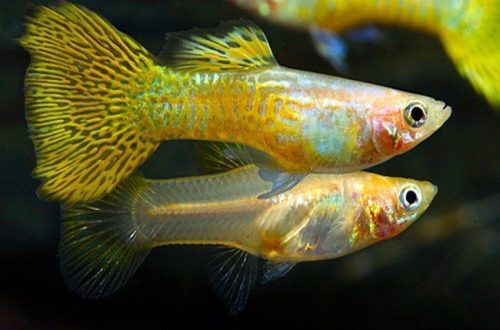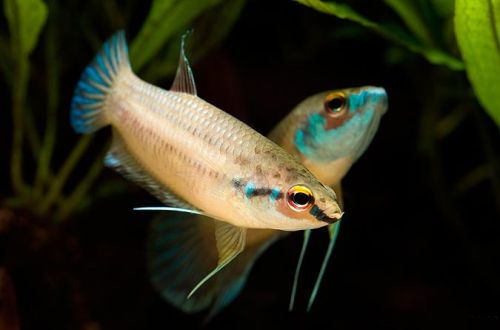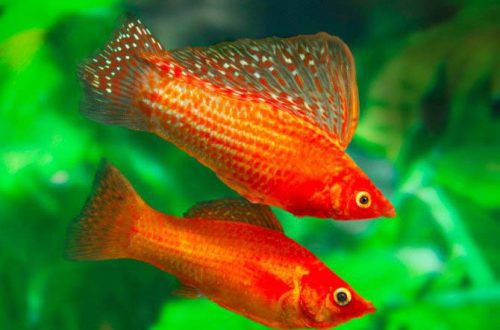
Poluryl Ravnaka
Ravnak’s half-snout, scientific name Nomorhamphus ravnaki, belongs to the family Zenarchopteridae (Half-snouts). In a number of sources, it is compared with guppies, meaning the unpretentiousness and endurance of this species. It is easy to keep and breed if kept in clean water and regularly maintained.

Contents
Habitat
The fish comes from the Indonesian island of Sulawesi (Celebes) in Southeast Asia. It occurs mainly in the southeastern part of the island, inhabiting numerous streams and rivers flowing down hilly terrain.
Brief information:
- The volume of the aquarium – from 120 liters.
- Temperature – 22-28°C
- Value pH — 6.5–7.0
- Water hardness – 4–18 dGH
- Substrate type – any
- Lighting – moderate
- Brackish water – no
- Water movement – moderate or strong
- The size of the fish is 6–12 cm.
- Nutrition – fresh or live food
- Temperament – conditionally peaceful
- Keeping in a group with one male and 3–4 females
Description

It is closely related to the species Nomoramphus Lima (subspecies liemi and snijdersi). It has a similar coloration and often appears together in the same shipments, which leads to confusion when one species is sold under a different name. However, this is not a problem, since both fish have identical requirements for their content.
The body is elongated and somewhat laterally compressed. The jaws are long, like those of river pikes, and the upper jaw is shorter than the lower. Males reach a length of about 6 cm, females are twice as large – up to 12 cm. The color is gray with a silvery belly. Differences with relatives lie in the color of the fins. The tail, dorsal and anal fins are reddish with a slight black edging along the edges. In addition, Ravnak’s Half-Snout has a red lower jaw and no characteristic hook-outgrowth.
Food
In nature, it feeds on small invertebrates such as insects and their larvae, crustaceans, worms and other zooplankton. On occasion, they will feast on small fish, fry. In a home aquarium, the diet should also contain a large amount of protein foods. It is noted that feeding takes place in the upper and middle layers of water, therefore, when choosing food, it is worth giving preference to floating products, or feeding through special feeders for live food.
Maintenance and care, arrangement of the aquarium

The optimal size of the aquarium for a group of 4-5 fish starts from 120-130 liters. The basis of the design composition should be a combination of open regions for swimming with areas that have numerous shelters from thickets of plants, intertwined snags or other decor.
For long-term maintenance, it is important to provide clean running water rich in dissolved oxygen. The presence of a moderate current is welcome. You can achieve the desired goal through regular maintenance of the aquarium and installed equipment. A mandatory procedure is the weekly replacement of part of the water with fresh water, which can be combined with the removal of organic waste using a siphon.
Behavior and Compatibility
Males are belligerent towards each other. In a small space, skirmishes are inevitable, sometimes fierce. If there are reliable shelters, then the weaker male will hide in them. However, this is not a solution to the problem. In small tanks, it is recommended to keep only one male in the company of 3-4 females. The latter are quite peaceful and can be in a group. Halfsnout Ravnak’s aggression only extends to males of its own and closely related species. Compatible with many freshwater fish of comparable size.
Breeding / breeding
In the artificial environment of the aquarium, there is no seasonality of reproduction. Fry will appear every 4-6 weeks. Parental instincts are not developed, so if the young are not transplanted in time, they will be quickly eaten. The fry appear large enough and are able to accept food from brine shrimp, daphnia, mosquito larvae, etc.
Fish diseases
If the fish is in a suitable environment for themselves, then cases of the disease are rare. The main causes of disease are poor-quality feed, poor water quality, and injuries. In some cases, it is enough to eliminate the negative impact on the body and he can cope with the disease. In advanced cases, medical treatment will be required, more details in the section “Diseases of aquarium fish”.





